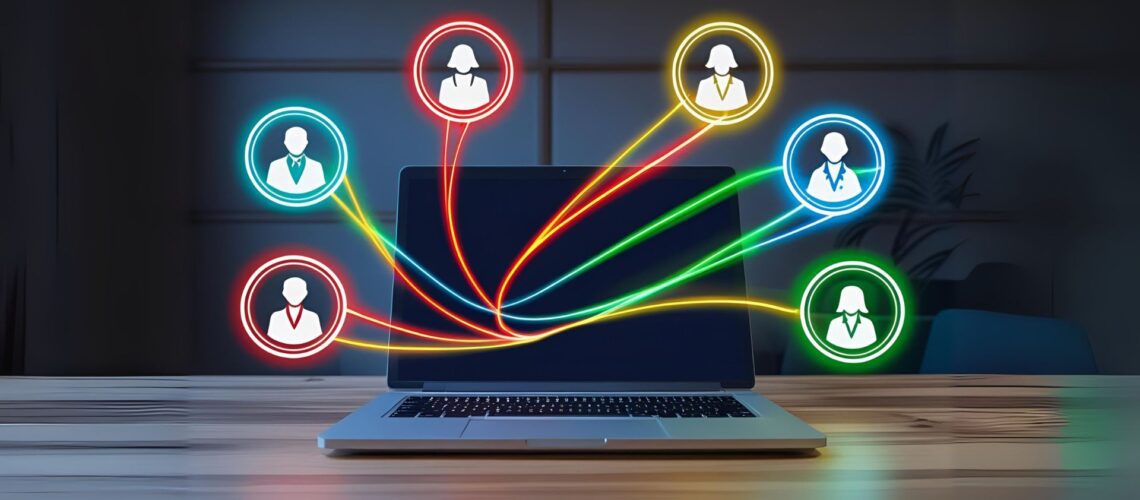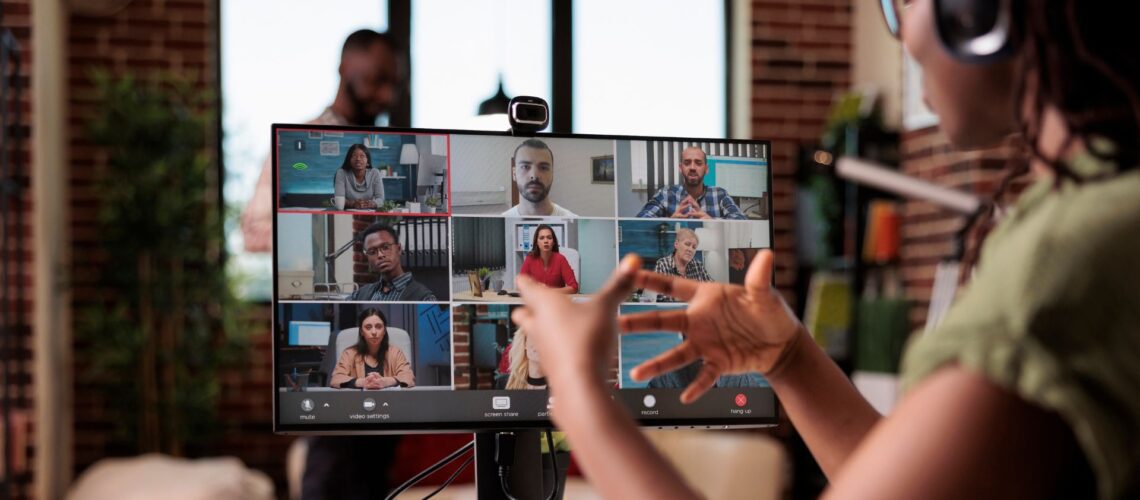Remote team management in technical environments presents unique challenges – from time zone barriers to vastly different communication styles. This article explores how Insights Discovery® provides a practical, people-focused framework for managing distributed technical teams more effectively.
You’ll discover:
- Why traditional management approaches fall short in remote tech teams
- How the four Insights Discovery® colour energies affect remote collaboration
- Practical strategies for tailoring communication, meetings, and workflows
- Tools and technologies to support colour-based remote team management
- Ways to build culture, recognise contributions, and evaluate team success
With 40% of British workers now operating remotely and 41% of managers struggling to manage distributed teams effectively¹, technical leaders need structured approaches that go beyond traditional management methods. Understanding individual communication preferences through Insights Discovery® becomes critical when face-to-face interaction cues are absent and digital communication dominates daily workflows.
The Remote Management Challenge in Technical Environments
Technical teams face unique obstacles when working remotely that extend beyond simple logistical concerns. Complex projects requiring collaboration between engineers, scientists, and technical specialists demand nuanced understanding of how each team member processes information, makes decisions, and responds to different communication approaches.
Without clear frameworks for understanding these differences, remote technical teams experience reduced productivity, miscommunication, and decreased morale. Research from Unily reveals that 77% of UK and US employees find work-based notifications distracting, with almost half (48%) being pulled away from their duties every half an hour. These challenges become magnified when managers lack insight into individual team members’ communication preferences and working styles.
Remote technical environments amplify personality-based communication differences that might be manageable in traditional office settings. Some team members thrive with structured, detailed project documentation. Others require regular verbal check-ins and collaborative problem-solving sessions. Some prefer asynchronous communication allowing time for reflection. Others need immediate, direct feedback and rapid decision-making processes.
Understanding the Four Colour Energies in Remote Technical Teams
Insights Discovery’s® four-colour model provides essential structure for remote team management by identifying distinct communication and collaboration preferences that affect virtual team dynamics.
Fiery Red Energy in Remote Settings
Team members with a dominant Fiery Red energy bring decisive leadership and results-focused approaches to remote technical teams. They prefer concise, direct communication and become frustrated with lengthy virtual meetings or detailed process documentation. When managing Fiery Red team members remotely, provide clear objectives, defined timelines, and regular progress updates without excessive detail.
Remote team members with a Fiery Red preference often struggle with the slower pace of digital communication and may become impatient with collaborative platforms requiring consensus-building. They excel when given autonomy to drive technical solutions and appreciate brief, focused video calls over lengthy email threads. Support their need for efficiency by establishing clear decision-making protocols and avoiding unnecessary virtual meetings.
Sunshine Yellow Energy in Remote Settings
Team members with a Sunshine Yellow preference thrive on interaction and relationship-building, making remote work particularly challenging for this energy type. They require regular social connection and collaborative brainstorming sessions to maintain engagement and creativity. Without adequate interpersonal interaction, Sunshine Yellow individuals may experience decreased motivation and energy.
Create structured opportunities for informal interaction through virtual coffee sessions, team celebrations, and collaborative project work. Encourage their natural storytelling abilities during virtual presentations and leverage their enthusiasm to maintain team morale. Ensure they have adequate outlets for verbal processing and idea generation through regular one-to-one sessions and group collaboration tools.
Earth Green Energy in Remote Settings
Team members with an Earth Green preference naturally adapt to remote work environments due to their patient, considerate approach to communication. They often excel at providing thoughtful responses via written communication and creating harmonious team dynamics even in virtual settings. However, they may struggle to assert their opinions in fast-paced video conferences or feel uncomfortable interrupting digital conversations.
Ensure individuals with an Earth Green preference have adequate time to process information and contribute to decision-making. Create psychologically safe spaces for their input through structured meeting formats, written feedback opportunities, and patient listening during virtual sessions. Their natural inclination towards supporting team harmony makes them valuable mediators in remote conflict resolution.
Cool Blue Energy in Remote Settings
Team members with a Cool Blue preference often thrive in remote technical environments due to their preference for detailed, structured communication and analytical approaches to problem-solving. They appreciate comprehensive documentation, logical project workflows, and time for thorough analysis of complex technical challenges.
However, they may become frustrated with unclear virtual meeting outcomes or insufficient technical documentation. Support their needs by providing detailed agendas, comprehensive project documentation, and follow-up summaries after virtual meetings. Ensure they have access to all necessary technical information and adequate time to analyse complex problems before requiring decisions.
Practical Strategies for Managing Remote Technical Teams
Effective remote team management using Insights Discovery® requires intentional adaptation of communication approaches, meeting structures, and project workflows to accommodate different energy types whilst maintaining technical excellence and project momentum.
Virtual Meeting Management
Structure virtual meetings to accommodate all four colour energies by beginning with clear agendas and defined outcomes (Cool Blue), allowing time for relationship-building and informal chat (Sunshine Yellow), ensuring everyone has opportunity to contribute (Earth Green), and maintaining focus on decisions and next steps (Fiery Red).
Rotate meeting leadership opportunities to leverage different energy strengths. Allow Cool Blue preferenced individuals to lead technical deep-dives, Fiery Red preferenced members to drive decision-making sessions, Sunshine Yellow preferenced team members to facilitate brainstorming meetings, and Earth Green preferenced individuals to moderate conflict resolution discussions.
Digital Communication Protocols
Establish communication guidelines that respect different processing styles and preferences. Some team members require immediate responses to urgent technical issues, whilst others need time to formulate thoughtful replies to complex questions. Create clear protocols distinguishing urgent communications requiring immediate response from detailed technical discussions allowing for reflective consideration.
Use multiple communication channels strategically – instant messaging for quick clarifications, email for detailed technical specifications, video calls for collaborative problem-solving, and project management tools for structured workflow tracking. Ensure all team members understand when to use each channel and respect different response timeframes based on communication type.
Project Workflow Design
Design project workflows that accommodate different working styles whilst maintaining technical standards and delivery timelines. Some remote team members work most effectively with detailed project documentation and structured milestone reviews. Others require regular verbal check-ins and collaborative problem-solving sessions.
Create flexible project structures allowing for different approaches to technical problem-solving whilst ensuring all team members remain aligned on objectives and deliverables. Use visual project tracking tools that provide clear progress indicators whilst allowing for different working preferences and communication styles.
Performance Management and Feedback
Adapt performance management approaches to suit remote working environments and individual communication preferences. Some team members require regular, detailed feedback on their technical contributions. Others prefer summary reviews focusing on outcomes and achievements. Some appreciate public recognition of their work, whilst others prefer private acknowledgement.
Establish regular one-to-one sessions tailored to individual needs – structured, objective-focused discussions for some team members, relationship-building conversations for others. Ensure feedback delivery matches individual preferences for direct, concise input or detailed, supportive guidance.
Technology Solutions for Insights Discovery® Colour-Based Remote Management
Leverage technology platforms that support different communication and collaboration preferences whilst maintaining technical project requirements and team connectivity across distributed locations.
Communication Platform Selection
Choose communication platforms offering multiple interaction modes to accommodate different colour energies. Ensure platforms provide instant messaging for quick clarifications, video conferencing for face-to-face interaction, screen sharing for technical collaboration, document collaboration for detailed reviews, and asynchronous communication options for reflective input.
Consider platforms with customisable notification settings allowing team members to manage digital interruptions according to their working preferences and concentration needs. Some individuals require immediate alerts for urgent technical issues, whilst others work more effectively with batched notifications during designated communication windows.
Project Management Integration
Implement project management tools that provide different views and interaction modes suited to various working styles. Visual dashboards appeal to team members requiring quick progress overviews, detailed task lists support those needing comprehensive project information, collaboration features enable interactive problem-solving, and reporting capabilities satisfy those requiring analytical project insights.
Ensure project management tools integrate effectively with communication platforms to provide seamless workflow management without requiring constant platform switching that can decrease productivity and increase frustration.
Building Remote Team Culture Through Insights Discovery®
Successful remote technical teams require intentional culture-building that acknowledges and celebrates different personality contributions whilst maintaining shared objectives and collaborative effectiveness.
Virtual Team Building
Design team-building activities that appeal to different colour energies and working preferences. Include structured problem-solving challenges for analytically-minded team members, creative brainstorming sessions for idea-generation enthusiasts, relationship-building activities for connection-focused individuals, and results-oriented competitions for achievement-driven personalities.
Create regular opportunities for informal interaction that don’t feel forced or artificial. This might include virtual coffee sessions, shared interest discussion groups, collaborative learning opportunities, or team celebration events recognising project achievements and individual contributions.
Recognition and Motivation
Adapt recognition approaches to individual preferences and energy types. Some team members appreciate public acknowledgement of their technical expertise and project contributions. Others prefer private recognition focusing on their collaborative support and relationship-building efforts. Some value immediate feedback on specific achievements, whilst others appreciate comprehensive reviews of their overall impact and development.
Ensure recognition programmes acknowledge different types of contributions – technical excellence, collaborative support, creative problem-solving, and leadership achievements – rather than focusing solely on individual deliverables or traditional performance metrics.
Measuring Success in Remote Technical Teams
Establish metrics and evaluation approaches that capture both technical project outcomes and team collaboration effectiveness whilst respecting different working styles and contribution types.
Productivity Assessment
Move beyond traditional productivity metrics to include collaboration quality, technical innovation, knowledge sharing, and team support contributions. Some team members excel at individual technical deliverables, whilst others provide crucial support through mentoring, problem-solving assistance, and team harmony maintenance.
Use multiple assessment approaches including peer feedback, client satisfaction measures, technical quality indicators, and team collaboration effectiveness ratings. Ensure evaluation criteria recognise different personality strengths and working preferences rather than imposing uniform performance expectations.
Team Effectiveness Indicators
Monitor team communication effectiveness, project collaboration quality, conflict resolution efficiency, and overall team morale alongside technical deliverables and project timeline adherence. Track indicators such as meeting effectiveness, communication response times, collaborative problem-solving success, and team member satisfaction with remote working arrangements.
Regular team retrospectives focusing on communication effectiveness and collaboration improvement provide valuable insights into how different colour energies are interacting and where adjustments might enhance overall team performance.

Frequently Asked Questions About Using Insights Discovery for Remote Team Management
Most remote technical teams notice immediate improvements in communication awareness and meeting effectiveness during initial training sessions. Sustained behavioural changes and enhanced collaboration typically develop over 3-4 months as team members practise adapting their communication styles in virtual environments. Early indicators include reduced meeting times, clearer digital communication, and improved conflict resolution.
Yes, Insights Discovery® is particularly valuable for distributed teams operating across time zones. Understanding communication preferences becomes crucial when team members have limited overlapping working hours. The framework helps teams optimise asynchronous communication, structure virtual handovers effectively, and ensure all personality types remain engaged despite geographical and temporal separation.
Insights Discovery® provides structured approaches for managing different working styles in remote technical environments. The framework helps project managers understand which team members need detailed documentation versus verbal updates, who requires collaborative problem-solving versus independent work time, and how to structure virtual project reviews to accommodate all personality types whilst maintaining technical standards and delivery timelines.
Building Stronger Remote Technical Teams
Insights Discovery® transforms remote team management by providing practical frameworks for understanding and leveraging individual communication preferences in virtual environments. For technical teams operating in today’s distributed working landscape, this understanding becomes a competitive advantage that drives both productivity and team satisfaction.
By implementing these evidence-based strategies, remote technical teams can overcome the inherent challenges of virtual collaboration whilst building stronger relationships, improving communication effectiveness, and maintaining high standards of technical excellence. The investment in understanding individual differences pays dividends through enhanced team performance, reduced conflict, and sustainable remote working success.


